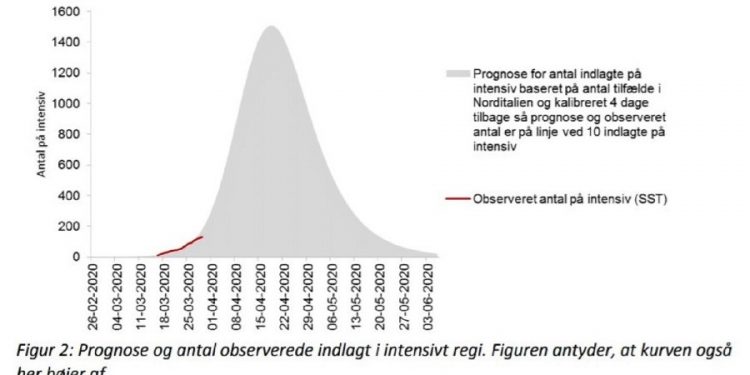Forecasted future development of the coronavirus epidemic

As the curve bends and becomes less steep, a careful and controlled opening of the Danish society is feasible, SSI states in their updated prognosis.
The article continues below.
By Bente D. Knudsen
It would seem that the spread of COVID-19 is slowing down the Danish infectious disease institute, SSI, who is responsible for the monitoring and analysis of the epidemic, says in their updated status report (as at 1 April) and therefore the institute can support a slow and gradual reopening of the Danish society after Easter.
At present there are 3,000 confirmed cases (from those tested), 535 are hospitalised, 146 are in intensive care and of these 129 are in a ventilator. 104 have died (all had other underlying health issues as well as COVID-19).
The strategy implemented in Denmark to reduce the spread of the virus seems to be working. The number of infections and hospitalisations is not rising as quickly as seen in other countries.
However, this does not mean that the everything will go back to normal from day one. The epidemic is not over and spread still needs to be controlled.
Therefore, restrictions such as keeping your distance, hand hygiene and other hygiene measures must be maintained for a long time, as well as avoiding gatherings in large crowds.
Based on the worst-case model for the coronavirus epidemic in Denmark, which the institute developed based on the outbreak in Northern Italy to match with Danish circumstances, it seems that the curve over newly admitted patients is bending.
“This is due to all the restrictions imposed and the change in behaviour observed,” the director of SSI, Kåre Mølbak says in the press release.
The article continues below.
Based on the current development, SSI has calculated the effective ratio of reproduction (this is the number of people to whom one person infected with COVID-19 spreads the virus) and according to SSI this shows a fall over time.
“The ratio is a measure that shows the epidemic is under control in Denmark,” Kåre Mølbak says and explains further that.
“Theoretically an epidemic can come under control because the population builds up immunity, or because the pressure of reproduction is reduced due to change in behaviour or other epidemic control measures.
We estimate that the reduction in Denmark is due to the behavioural change and the many measures taken to reduce spread. We are still too early in the epidemic to see any impact of immunity.”
The article continues below.
That the change in behaviour has had an impact can also been seem from the very marked reduction in influenza cases during the same period, as the measures also impact on the spread of influenza, which is transmitted in much the same way as the virus, however with a shorter period of incubation.
This also means that the epidemic will last longer in Denmark, which is now entering into its fifth week, than the short 12-week period that a steep curve and a high spread would have given.
“As it seems that the curve bends, and the pressure of spread falls, it is more likely that instead of a short 12-week epidemic with a steep curve (the red one), we will instead have a longer lasting epidemic with a less steep peak. In other words, we are on the green curve of the epidemic and not on the red one,” Kåre Mølbak says.
A gradual reopening of the society is feasible SSI writes in the report.
If the current measures are maintained over a longer period of time, SSI judges that the epidemic will continue in a relatively calm way which means that the risk of overload of the medical system as seen in Northern Italy is more unlikely.
The article continues below.
Support our magazine with a contribution of any size
We do not want to put up a pay-wall, so we need your support and if you find our content relevant and worthwhile, we would value any contribution, however big or small, as a token of your appreciation of our efforts.
How to support:
Transfer any contribution to our bank account at: Your Danish Life/ Danish Expat Media Aps
Danske Bank account number: 3409 11405673
IBAN: DK68 3000 0011 4056 73
or MobilePay to 2144 1224
Message: Support
The institute concludes in their report that the pressure of spread in Denmark in now at a level where it would be admissible to lift some of the restrictions and start a responsible, step by step controlled reopening of the society.
This will require that the population still shows discipline, keeps social distance and maintains a high level of (hand) hygiene. Otherwise the spread could again come out of control, the report concludes.
“If, however, it is decided to lift all measures as of 13 April, spread will rise considerably. If this happens, we estimate that the challenges for the medical system will be considerable and there is a huge risk that the capacity of our intensive care units is surpassed,” Kåre Mølbak underlines.
Depending on the progression of spread over the Easter period and the how well the population continues to respect the measures put in place, the Danish Government suggested at a press meeting on Monday 30 March that it may be possible to start a slow and careful reopening of parts of the society again after Easter.
“At present, how and what sectors (schools, universities, public employees, private businesses) might be the first to return is being analysed together with the health authorities and other experts, the private sector, and in discussion with the other political parties in parliament,” Mette Frederiksen said at the press meeting.

